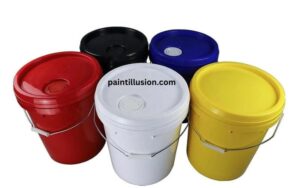When embarking on a painting project, it’s important to consider the weight of the paint you’ll be using. Whether you’re a professional painter or a DIY enthusiast, understanding the weight of a 5-gallon bucket of paint can be crucial for planning, transportation, and safety. In this article, we’ll explore the factors that affect the weight of paint, discuss the different types of paint and their weight variations, and provide you with tips on how to calculate and handle paint weight effectively.
Factors that affect the weight of paint
The weight of a 5-gallon bucket of paint can vary based on several factors. One of the primary factors is the type of paint being used. Different types of paint have different densities, which directly impact their weight. For example, latex paint is generally lighter than oil-based paint. Additionally, the sheen level of the paint can also play a role in its weight. High-gloss paints tend to be heavier than flat or matte finishes.
Another factor to consider is the composition of the paint. Some paints contain additives or fillers that can increase their weight. These additives are often used to enhance properties such as durability, coverage, or drying time. The presence of these additives can cause variations in the weight of paint from one brand to another.
Understanding the density of paint
To understand the weight of paint, it’s important to grasp the concept of density. Density refers to the mass of a substance per unit volume. In the case of paint, density is typically measured in pounds per gallon (lbs/gal) or kilograms per liter (kg/L). The higher the density, the more mass the paint contains per unit volume. Different types of paint have different densities due to variations in their formulation and ingredients.
Density is influenced by factors such as the type and amount of pigments, binders, solvents, and additives present in the paint. For example, oil-based paint tends to have a higher density compared to water-based paints due to the presence of heavier solvents and oils. By understanding the density of paint, you can better estimate its weight.

Different types of paint and their weight variations
Now let’s explore how the weight of paint can vary among different types. Latex or water-based paints are generally lighter in weight compared to oil-based paints. On average, latex paint weighs around 10 pounds per gallon (1.2 kg/L), while oil-based paint can weigh up to 15 pounds per gallon (1.8 kg/L). It’s important to note that these are general averages, and the weight can vary depending on the specific brand and formulation.
Within each type of paint, different finishes can also affect the weight. For instance, flat or matte finishes tend to be lighter in weight compared to semi-gloss or high-gloss finishes. This is because higher sheen levels often require additional additives, which can increase the weight of the paint. Therefore, it’s essential to consider both the type of paint and the desired finish when estimating its weight.
How to calculate the weight of a 5-gallon bucket of paint
Calculating the weight of a 5-gallon bucket of paint is relatively straightforward once you know the density. Here’s a step-by-step guide on how to do it:
- Determine the density of the paint: Check the paint can label or manufacturer’s information to find the density in pounds per gallon (lbs/gal) or kilograms per liter (kg/L).
- Convert the density to pounds per 5 gallons: Multiply the density by 5 (since there are 5 gallons in a bucket) to obtain the weight of paint per 5-gallon bucket.
- Example calculation: If the density of the paint is 10 lbs/gal, the weight of a 5-gallon bucket would be 10 lbs/gal x 5 gal = 50 pounds.
By following this calculation method, you can accurately estimate the weight of a 5-gallon bucket of paint for your specific project.
Common misconceptions about the weight of paint
There are a few common misconceptions surrounding the weight of paint that are important to address. One such misconception is that all paint weighs the same. As we discussed earlier, different types of paint have different densities, resulting in variations in weight. It’s crucial to consider the type and formulation of paint when estimating its weight.
Another misconception is that the weight of paint is solely determined by its color. While it’s true that certain pigments can add weight to the paint, the overall composition and formulation play a more significant role in determining its weight. Color alone is not a reliable indicator of the weight of paint.
Tips for handling and transporting paint safely
When dealing with the weight of paint, it’s essential to prioritize safety. Here are some tips for handling and transporting paint safely:
- Use proper lifting techniques: When moving heavy paint containers, lift with your legs and not your back to avoid straining your muscles or causing injury.
- Secure the containers: Ensure that the lids of the paint containers are tightly sealed to prevent spills during transportation. Consider using additional protective measures such as plastic wrap or tape for added security.
- Distribute weight evenly: If you have multiple paint containers, distribute the weight evenly in your vehicle to maintain balance. This will help prevent accidents or damage due to an imbalance.
- Follow local disposal guidelines: When disposing of paint, follow your local regulations for proper disposal methods. This helps protect the environment and ensures compliance with waste management laws.
By following these safety tips, you can mitigate the risks associated with handling and transporting paint.
Other considerations when estimating paint weight for projects
When estimating the weight of paint for your projects, there are a few additional considerations to keep in mind:
- Coverage area: The coverage area of the paint can affect the quantity needed for your project. Consider the surface area you’ll be painting to determine the amount of paint required. This will help you estimate the overall weight more accurately.
- Multiple coats: If you plan on applying multiple coats of paint, remember to account for the additional weight. Multiply the weight of a single coat by the number of coats to get a more precise estimate.
- Storage conditions: Paint can change in weight due to evaporation or absorption of moisture. Store paint in a cool and dry place to maintain its weight consistency over time.
By considering these factors, you can ensure that your paint estimation is more accurate and tailored to your specific project needs.
Conclusion
Understanding the weight of a 5-gallon bucket of paint is crucial for effective project planning, transportation, and safety. By considering the factors that affect paint weight, understanding the density of paint, and calculating the weight accurately, you can better estimate the amount of paint needed for your projects. Additionally, following safety guidelines and considering other project-specific factors will help you handle and transport paint safely. So, the next time you embark on a painting project, remember to take the weight of paint into account for a successful and hassle-free experience.
CTA: Whether you’re a professional painter or a DIY enthusiast, understanding the weight of paint is essential for your projects. Take the time to calculate and estimate the weight accurately to ensure smooth transportation and safe handling. Happy painting!

